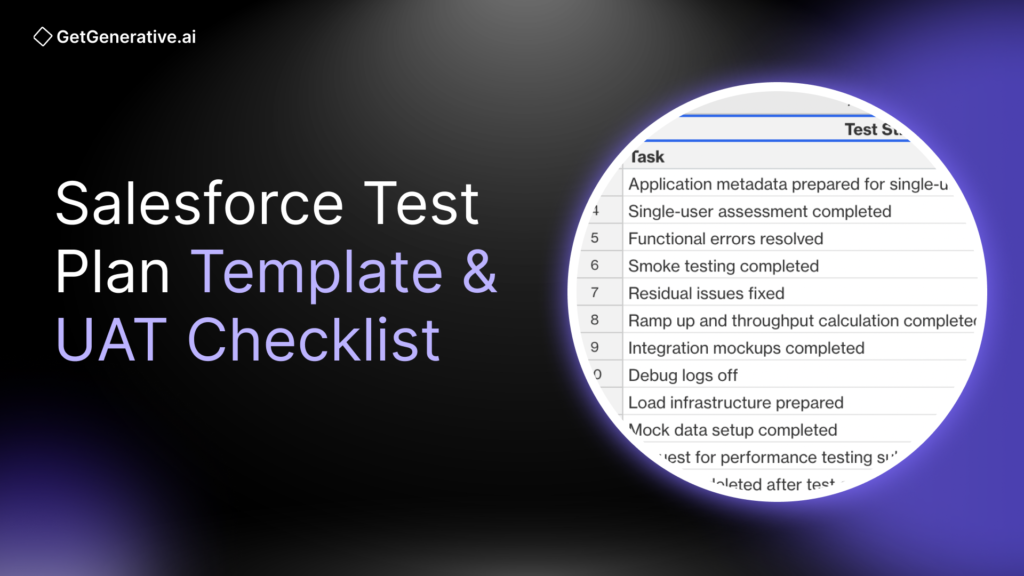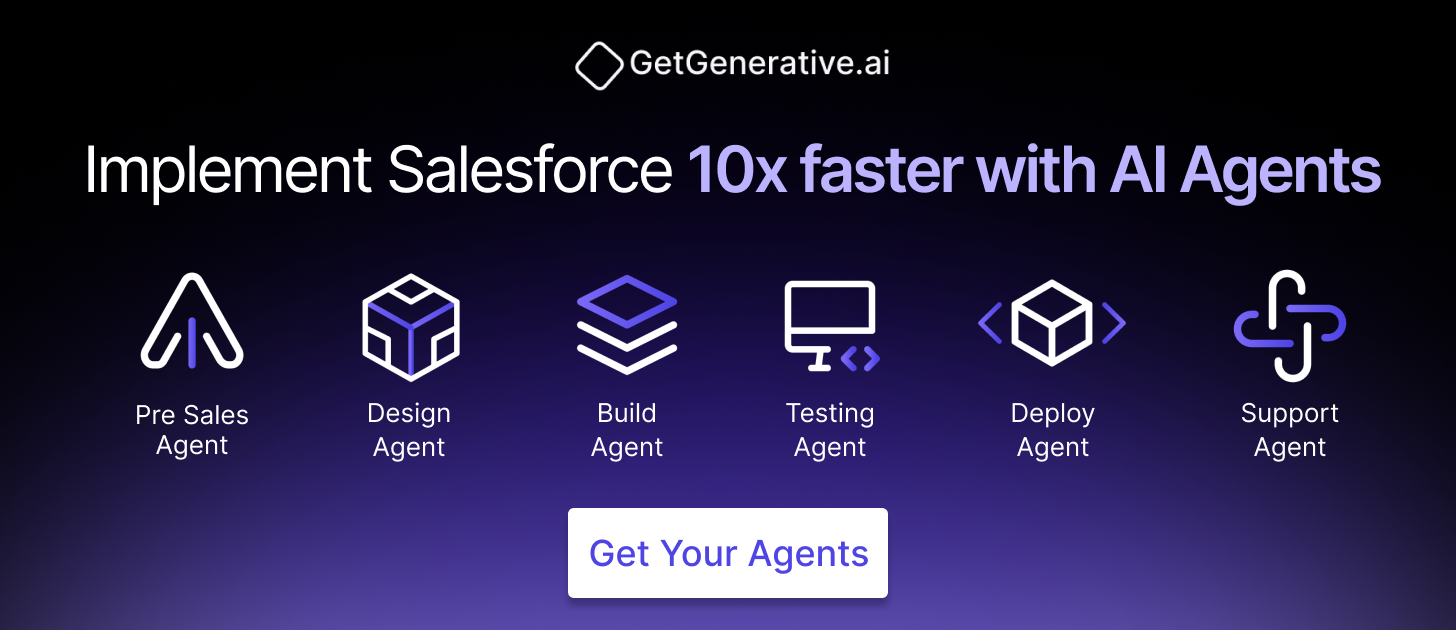Salesforce Test Plan Template & UAT Checklist
In large-scale Salesforce implementations, success is not just about delivering features—it’s about delivering reliable, user-approved, and business-aligned functionality. A strategic test plan and a rigorous User Acceptance Testing (UAT) process are essential pillars of that success.
Consider this: nearly 70% of digital transformation initiatives fail primarily due to poor user adoption. Even more striking, the cost of fixing a bug in production can be 30 times higher than fixing it during development. These facts underscore the need for a mature quality assurance approach in any Salesforce project, especially those involving Sales Cloud, Service Cloud, CPQ, or industry-specific customizations.
This comprehensive guide provides a Salesforce test plan template and a UAT checklist, tailored specifically for Salesforce professionals. You’ll learn:
- The key components of a Salesforce test plan
- How to execute high-impact UAT
- How to balance manual and automated testing
- DevOps integration for continuous testing
Why a Salesforce Test Plan Is Mission-Critical
A Salesforce test plan isn’t just a document—it’s your quality blueprint. It aligns technical teams and business stakeholders around what needs to be tested, how it will be tested, when, and by whom. Here’s why it matters:
1. Avoid Expensive Failures
Bugs caught in production are 4x to 30x more costly to fix than those found early. A simple error in a lead assignment rule or approval process can cripple sales for weeks if it goes unnoticed.
2. Ensure Business Alignment
UAT embedded within the test plan ensures that the final product meets actual business needs, not just functional specifications. Engaging real users early improves adoption and avoids costly post-go-live adjustments.
3. Maintain Compliance & Auditability
In regulated sectors like finance or healthcare, documented test plans and sign-offs are often required. Even for non-regulated industries, test documentation boosts internal accountability.
4. Mitigate Project Risk
With integrations, custom code, Flows, and third-party tools in play, Salesforce orgs are complex ecosystems. A test plan breaks this complexity into manageable, testable units, reducing risk at every turn.
Salesforce Test Plan Template: What to Include
Here’s a fully structured Salesforce test plan outline—adaptable to any Salesforce cloud or project type:
1. Objectives and Scope
- Goals: Validate configuration, integrations, automations, and customizations.
- In Scope: E.g., Opportunity-to-Quote workflows in Sales Cloud, Service SLA automation in Service Cloud, CPQ quote generation.
- Out of Scope: E.g., legacy ERP integration not yet connected.
2. Test Types and Phases
- Unit Testing: Minimum 75% Apex code coverage, ideally more for critical modules.
- System Testing: Validate end-to-end functionality and regression.
- Integration Testing: Test Salesforce-ERP, Salesforce-Marketing Cloud data flows.
- User Acceptance Testing (UAT): Covered in detail in the next section.
- Performance or Security Testing: Where applicable, especially in high-volume orgs.
3. Roles and Responsibilities
Role | Responsibilities |
QA Analyst | Writes and executes test cases |
Developer | Fixes defects, writes Apex tests |
Business UAT Tester | Tests real-world processes |
UAT Lead | Manages testers, test scripts |
Project Sponsor | Final sign-off for go-live |
4. Test Environments and Data Strategy
- UAT Sandbox: Full-copy, refreshed monthly, with masked production data.
- Developer Sandboxes/Scratch Orgs: Used for unit testing.
- Data Seeding: Via Data Loader, SFDX scripts, or GetGenerative’s automated data setup.
- Tools: Salesforce DevOps Center, Jira, TestRail, or Provar.
5. Test Cases and Scenarios
- Traceability Matrix linking test cases to requirements
- Real-world scenarios: e.g., Lead > Opp > Quote > Order flow
- Positive + Negative + Edge Cases: e.g., validation rule failures, integrations down
Also Read – Salesforce Requirements with AI: Epics, User Stories & Acceptance Criteria
The Strategic Role of UAT in Salesforce Implementations
In the Salesforce implementation lifecycle, User Acceptance Testing (UAT) is more than a QA milestone—it’s the final gate where business stakeholders confirm that what’s been built actually serves their goals. It’s not about whether the code works—it’s about whether the solution works for the user.
For Salesforce, UAT is critical because the platform often supports core operations—sales, customer service, billing, partner portals—where even a small misstep can impact revenue or customer trust.
Key Reasons UAT Matters:
- Validates Business Requirements: Functional testing confirms features work. UAT ensures they’re useful in real-life business contexts.
- Boosts Adoption: Involving users early creates ownership and eases change management.
- Ensures End-to-End Process Coverage: Especially important in integrated flows—e.g., Salesforce → ERP → Finance systems.
- Uncovers Role-Specific Gaps: Missing permissions, broken visibility rules, or profile-specific issues often surface in UAT.
- Formalizes Go-Live Readiness: UAT sign-off is a contract: the business confirms the system is ready.
Salesforce UAT Checklist
Use this comprehensive checklist to ensure a structured and complete UAT process in any Salesforce rollout:
# | Task | Notes |
1 | Define clear business goals and acceptance criteria | Align each user story or requirement with expected UAT outcomes |
2 | Identify and onboard UAT testers | Include business owners, power users, and cross-functional reps |
3 | Provide training or walkthrough sessions | Especially for custom flows, new objects, or changed UI |
4 | Finalize UAT test scenarios | Base on real business workflows, not just system functions |
5 | Prepare UAT sandbox and data | Full-copy sandbox preferred; mask production data if needed |
6 | Validate user permissions and access | Ensure testers can execute flows and view relevant data |
7 | Execute UAT test cases | Track all outcomes: passed, failed, blocked, or needs retest |
8 | Log and triage issues in Jira or test tracker | Include screenshots, repro steps, business impact |
9 | Retest after fixes | Prioritize retests for showstoppers and integration failures |
10 | Final regression run (optional but recommended) | Confirm that critical paths still work after bug fixes |
11 | Obtain business sign-off | Secure email/document from sponsors approving go-live |
12 | Debrief and capture lessons | Feed findings into training, documentation, and future releases |
Real-World Example
Let’s say a healthcare services provider rolls out Salesforce Service Cloud to support patient interactions. During UAT, a customer service rep tries to escalate a high-priority case to a medical review team, but the case visibility doesn’t propagate due to role hierarchy misconfiguration.
This bug had passed functional testing (since escalation rules triggered correctly in QA). But in UAT, real users testing with realistic roles uncovered the visibility gap, preventing a critical handoff from happening. The fix was as simple as a sharing rule adjustment, but without UAT, the issue would’ve surfaced post-go-live, potentially affecting patient care and SLAs.
UAT Sign-Off: The Business “Green Light”
The ultimate goal of UAT is formal approval by stakeholders. Once:
- All critical test scenarios pass,
- Business-impacting bugs are resolved,
- Any known issues are accepted with mitigation plans,
…the UAT sign-off document can be issued. This provides traceable accountability that the system is ready for deployment.
✍️ Recommendation: Use a standardized sign-off form with version control, signatories, and a summary of passed/failed tests.
Tools That Support UAT in Salesforce
- Jira or Azure DevOps: For issue logging, test case tracking, workflows
- Salesforce DevOps Center: Track deployments and user stories aligned with UAT tasks
- TestRail / Zephyr: Structured test case repositories, linked to requirements
- GetGenerative.AI’s Testing Agent: Generates test plans, UAT scripts, and documents test evidence automatically
✅ Time-saving Tip: Use GetGenerative.AI to generate your initial UAT test scripts and acceptance criteria directly from Salesforce user stories. It can even generate a first draft of your UAT summary report post-testing.
Transitioning from UAT to Go-Live
Before go-live, ensure:
- All documentation from UAT is archived
- Outstanding issues are logged for the next sprint
- User training materials are updated based on UAT feedback
Also, communicate go-live readiness in an org-wide update: highlight UAT success, key improvements, and what to expect post-launch. This builds confidence and paves the way for a smoother transition.
Balancing Manual and Automated Testing in Salesforce QA
Both manual and automated testing play pivotal roles in a modern Salesforce quality assurance strategy. The key is knowing when to use which.
Manual Testing
Manual testing shines where human judgment, visual feedback, or ad hoc exploration are required.
Use cases include:
- UAT: Business users test real-world scenarios with context and intuition.
- UX Evaluation: Testers evaluate screen layouts, error messages, and usability.
- Exploratory Testing: Creative edge-case testing outside scripted paths.
- Initial Feature Validation: Early feedback loops for new features not yet automated.
Limitations:
- Time-consuming
- Not scalable for regression
- Prone to inconsistency
Automated Testing
Automated tests reduce human error and excel at regression, performance, and code-level validation.
Key layers of Salesforce automation:
- Apex Unit Tests: Required for deployment, with 75% minimum code coverage.
- UI Automation: Tools like Selenium, Provar, and ACCELQ test Lightning components.
- API Testing: REST/SOAP validations using Postman, JMeter, or ReadyAPI.
- Performance Testing: Load simulation using JMeter or BlazeMeter.
- CI/CD Regression: Run nightly test suites or post-deployment validations.
✅ Example: Automating the Opportunity-to-Quote workflow via Provar saves 30+ hours across multiple sprints and prevents human error in multi-stage approvals.
Best Practice: Hybrid Testing Strategy
What to Automate | What to Keep Manual |
High-volume regressions | One-off validations |
Critical user flows | UAT edge-case testing |
Backend rules & triggers | First-run feature tests |
Data-driven workflows | UI/UX evaluations |
Embedding QA into Salesforce DevOps
Modern Salesforce teams don’t treat QA as a phase—they embed it into DevOps pipelines and Agile release cycles.
DevOps QA Benefits:
- Shift-Left Testing: Detect bugs at commit time, not UAT.
- Faster Feedback Loops: Automate unit/integration tests in CI/CD.
- Release Agility: Move from quarterly to bi-weekly releases with confidence.
- Sandbox Strategy: Automate scratch org creation, testing, and teardown.
Common Tools:
- Copado, Gearset, Flosum: Deployment and test orchestration
- GitHub Actions, Azure DevOps: CI/CD pipelines with testing hooks
- SFDX & Scratch Orgs: Temporary environments for automated test runs
- Salesforce DevOps Center: Integrate user stories, deployments, and test validations
Case Study: A U.S. retail chain reduced UAT time by 50% after embedding automated regression testing in its GitLab pipeline. Their change failure rate dropped from 18% to under 5%, thanks to early bug detection.
AI-Powered Salesforce Testing with GetGenerative.AI
- Auto-Generate Test Plans & Test Cases
- Converts user stories and metadata into test scenarios
- Drafts structured test plans with traceability built-in
- Script Generation
- Suggests Apex unit tests and Selenium-based test scripts
- Integrates with Einstein GPT for developer-level test code
- AI-Powered Prioritization
- Identifies high-risk areas based on past bugs and recent changes
- Recommends regression test sequence intelligently
- UAT Support
- Generates UAT documentation and test evidence
- Summarizes test execution into approval-ready reports
- Continuous QA Collaboration
- Syncs with Jira and DevOps tools
- Seamlessly integrates with Build and Deploy Agents
Also Read – How to Generate Apex Code with AI
Final Recommendations
- Institutionalize Test Plans and UAT: Use the templates provided as project baselines.
- Adopt DevOps Testing Practices: Shift testing left, automate regression, and iterate faster.
- Leverage AI-Driven Tools: Accelerate planning, execution, and documentation with platforms like GetGenerative.AI.
- Focus on User-Centric Validation: Always include real users in testing cycles—not just for sign-off, but for feedback.
Conclusion
A Salesforce project that skips testing is a gamble. But one that embraces structured planning, robust UAT, automation, and AI-enhanced QA is built for long-term success.
By following this complete guide from test planning and UAT to automation and AI, you’ll ensure that every release is smooth, every feature is trusted, and every user feels confident using your CRM.
If you’re looking to take the guesswork out of Salesforce projects, GetGenerative.ai offers a thoughtful way to plan, build, and test with clarity. From proposals to go-live, it helps teams stay focused and aligned.
Book your demo today!




